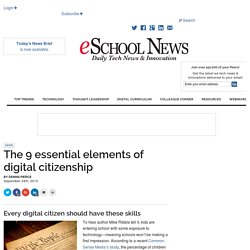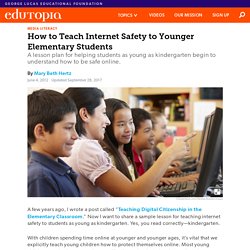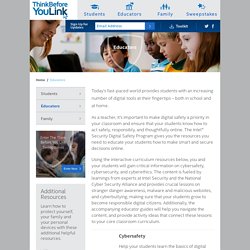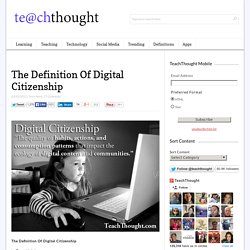

Digital citizenship is more than staying safe online, says ISTE's chief executive. eSchool News The 9 essential elements of digital citizenship. Every digital citizen should have these skills To hear author Mike Ribble tell it, kids are entering school with some exposure to technology—meaning schools won’t be making a first impression.

According to a recent Common Sense Media’s study, the percentage of children ages eight and under who’ve used a mobile device nearly doubled from 2011 to 2013, from 38 percent to 72 percent. And about two in five children under the age of two have used a mobile device. “Whether they have a knowledge of how to use it appropriately is another question,” said Ribble, the author of Digital Citizenship in Schools and the chair of ISTE’s digital citizenship PLN. Findings like the ones outlined by Common Sense suggest the need for schools to start teaching good digital citizenship to students at a very young age—and Ribble and many others believe that students should learn these skills throughout the K-12 curriculum. Digital Bytes. Digital Citizenship. How to Teach Internet Safety to Younger Elementary Students.
A few years ago, I wrote a post called “Teaching Digital Citizenship in the Elementary Classroom.”

Now I want to share a sample lesson for teaching internet safety to students as young as kindergarten. Yes, you read correctly—kindergarten. With children spending time online at younger and younger ages, it’s vital that we explicitly teach young children how to protect themselves online. Most young children get the “stranger danger” talk at school, so they know about how to handle strangers in their neighborhood and in face-to-face situations.
There are three considerations when addressing internet safety with these students. Protecting Private Information Online This is a lesson I’ve done with my kindergarten and first-grade students to introduce the idea that strangers exist on the internet and to discuss how we should interact with them. “What is a stranger?” Have students watch the Internet Safety video at BrainPOP Jr. More Resources. Safety.pdf. Revised%20AUP%20March%202013_final.pdf. Think Before You Link. Today’s fast-paced world provides students with an increasing number of digital tools at their fingertips – both in school and at home.

As a teacher, it’s important to make digital safety a priority in your classroom and ensure that your students know how to act safely, responsibly, and thoughtfully online. The Intel® Security Digital Safety Program gives you the resources you need to educate your students how to make smart and secure decisions online.
Using the interactive curriculum resources below, you and your students will gain critical information on cybersafety, cybersecurity, and cyberethics. The content is fueled by learnings from experts at Intel Security and the National Cyber Security Alliance and provides crucial lessons on stranger danger awareness, malware and malicious websites, and cyberbullying, making sure that your students grow to become responsible digital citizens. Cybersafety Cybersecurity. East Chapel Hill High School - General User Policy.
InCtrl. Information Fluency & Forensics. Definition Of Digital Citzenship. The Definition Of Digital Citizenship by Terry Heick As more and more students interact digitally–with content, one another, and various communities–the concept of digital citizenship becomes increasingly important.

Which begs the question: what is digital citizenship? Well, first citizenship, which is formally defined as “the quality of an individual’s response to membership in a community.” This makes citizenship far more complex than a simple legal matter, but rather one that consists of self-knowledge, interaction, and intimate knowledge of a place, its people, and its cultural history. So digital citizenship is nearly the same thing–“the quality of a response to membership in a digital community” would be a good first crack at the definition.
But that leaves out the idea of content itself, which leads us to a pretty good definition for educators: “The quality of habits, actions, and consumption patterns that impact the ecology of digital content and communities.” Still too wordy? Selecting the best information source.